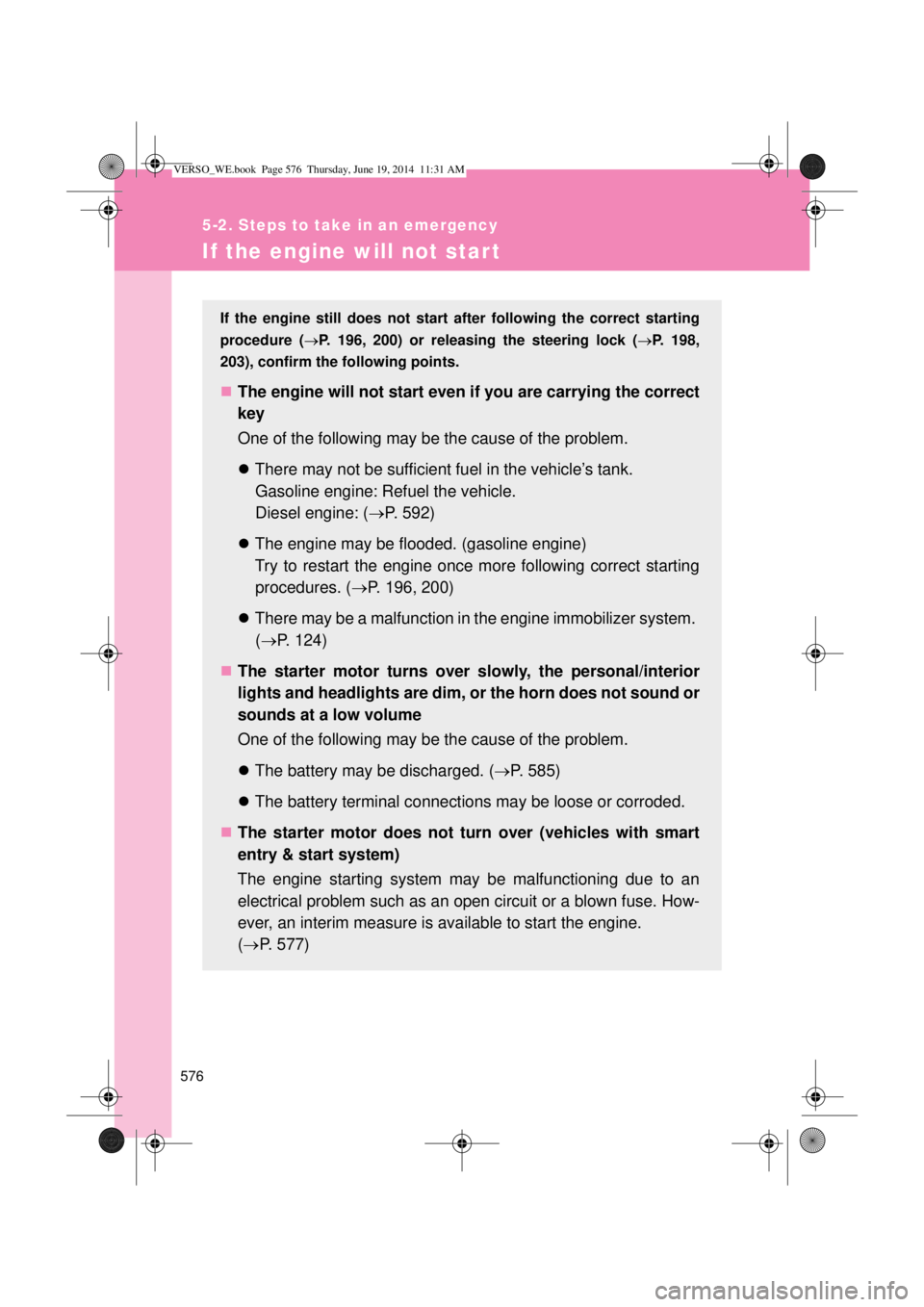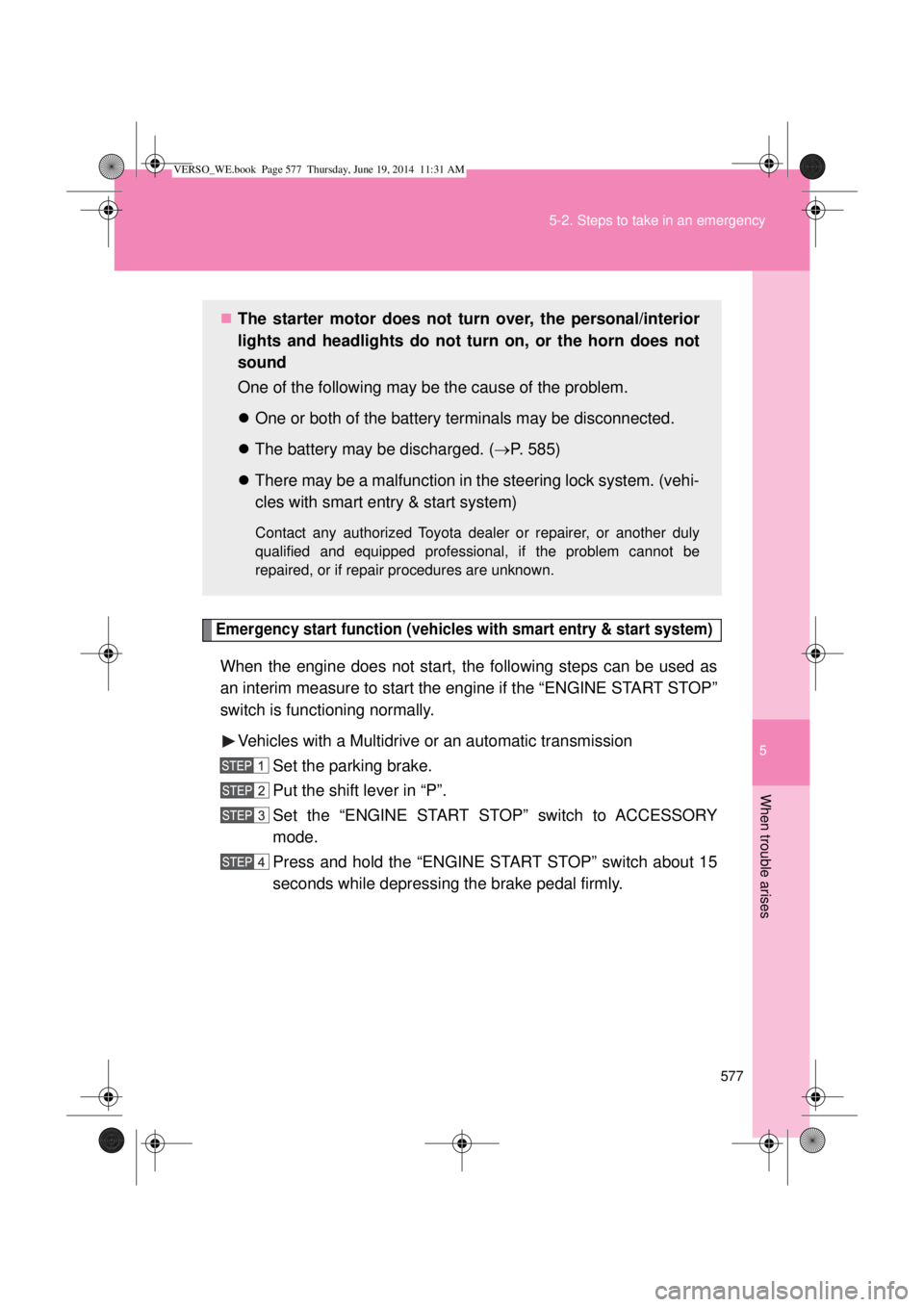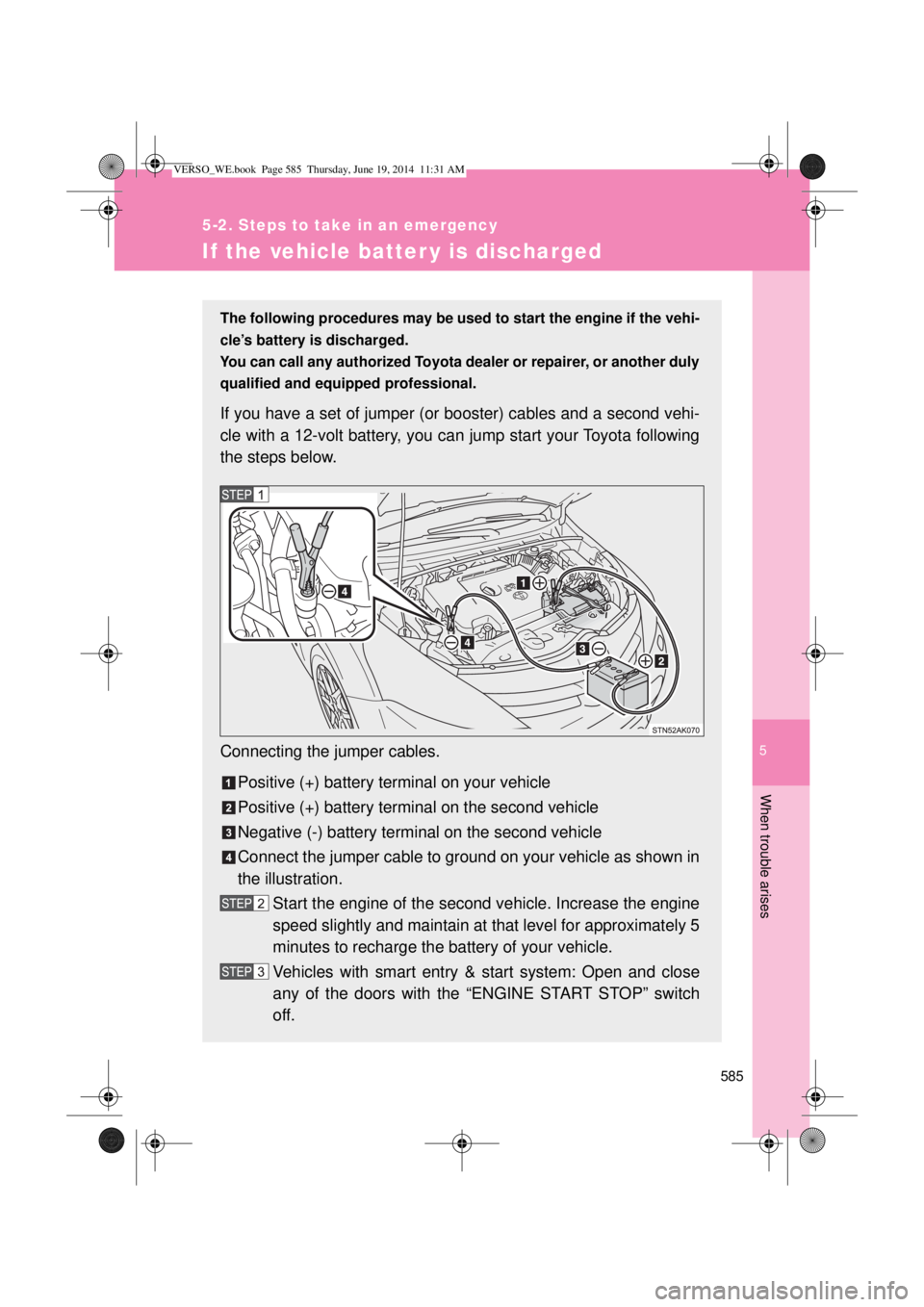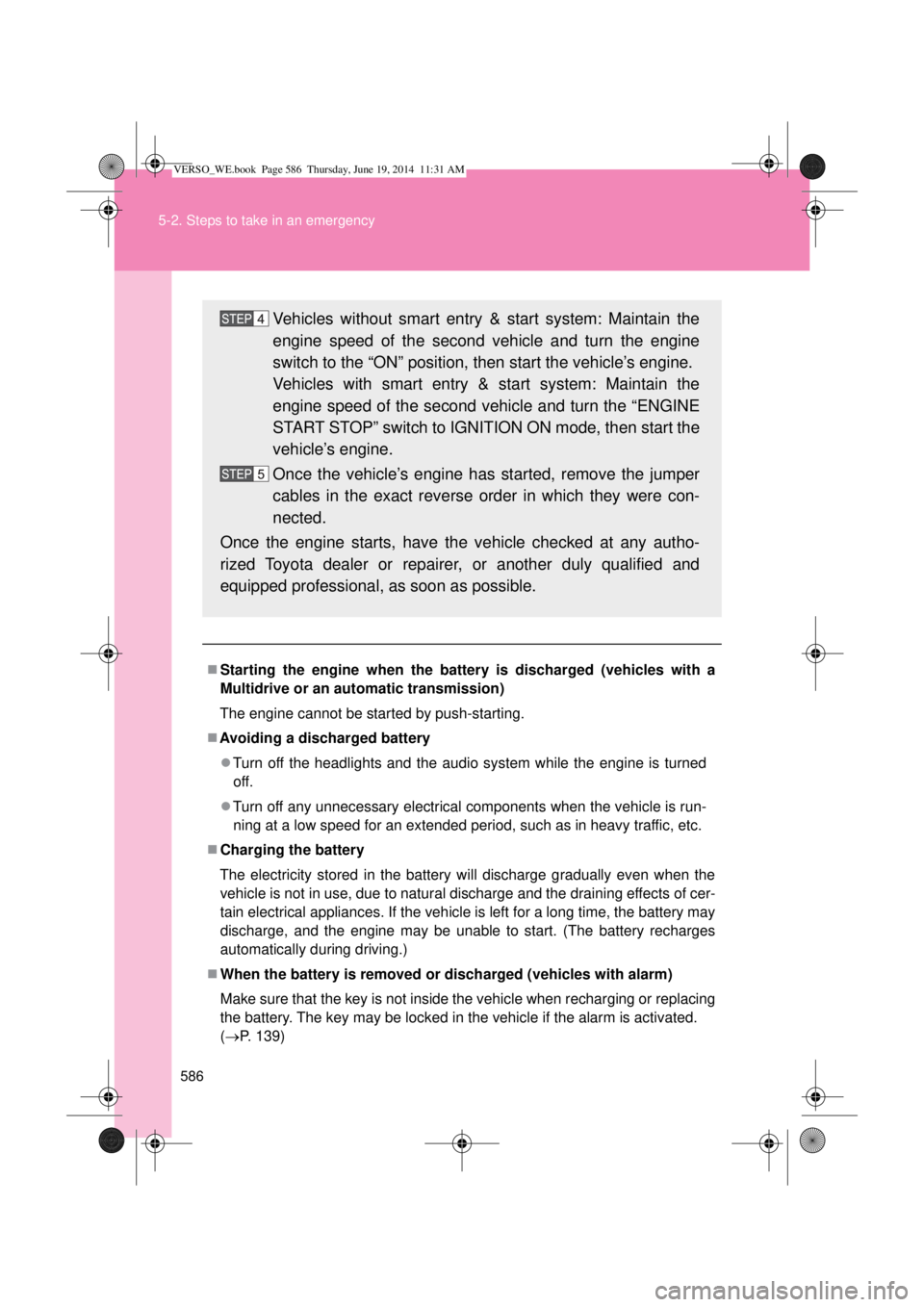Page 533 of 650
5
533 5-2. Steps to take in an emergency
When trouble arises
Once
*1
(Flashes)Indicates that
the electronic
key does not
operate prop-
erly.Press the
“ENGINE
START STOP”
switch while
applying the
brakes.
Once
*2
(Flashes)Indicates that
the electronic
key does not
operate prop-
erly.Press the
“ENGINE
START STOP”
switch while
applying the
clutch pedal.
Once
*1
(Flashes)Indicates that
the shift lever
out of “P” or “N”
and turned to
the “ENGINE
START STOP”
switch off.Turn the
“ENGINE
START STOP”
switch off to
after shift the
shift lever to “P”.
Indicates that
the auto power
off function.Start the
engine.
Increase the
engine speed
slightly and
maintain at that
level for approx-
imately 5 min-
utes to recharge
the battery of
your vehicle.
Interior
buzzerExterior
buzzerWarning messageDetailsCorrection
procedure
VERSO_WE.book Page 533 Thursday, June 19, 2014 11:31 AM
Page 534 of 650
534 5-2. Steps to take in an emergency
OnceIndicates that
the key battery
is low.Replace the
battery.
*1
(Flashes)Indicates that a
door has been
opened or
closed and the
“ENGINE
START STOP”
switch has been
switched twice to
ACCESSORY
mode from off.Press the
“ENGINE
START STOP”
switch while
applying the
brakes.
*2
(Flashes)Indicates that a
door has been
opened or
closed and the
“ENGINE
START STOP”
switch has been
switched twice to
ACCESSORY
mode from off.Press the
“ENGINE
START STOP”
switch while
applying the
clutch pedal.
Interior
buzzerExterior
buzzerWarning messageDetailsCorrection
procedure
VERSO_WE.book Page 534 Thursday, June 19, 2014 11:31 AM
Page 576 of 650

576
5-2. Steps to take in an emergency
If the engine will not start
If the engine still does not start after following the correct starting
procedure (P. 196, 200) or releasing the steering lock (P. 198,
203), confirm the following points.
The engine will not start even if you are carrying the correct
key
One of the following may be the cause of the problem.
There may not be sufficient fuel in the vehicle’s tank.
Gasoline engine: Refuel the vehicle.
Diesel engine: (P. 592)
The engine may be flooded. (gasoline engine)
Try to restart the engine once more following correct starting
procedures. (P. 196, 200)
There may be a malfunction in the engine immobilizer system.
(P. 124)
The starter motor turns over slowly, the personal/interior
lights and headlights are dim, or the horn does not sound or
sounds at a low volume
One of the following may be the cause of the problem.
The battery may be discharged. (P. 585)
The battery terminal connections may be loose or corroded.
The starter motor does not turn over (vehicles with smart
entry & start system)
The engine starting system may be malfunctioning due to an
electrical problem such as an open circuit or a blown fuse. How-
ever, an interim measure is available to start the engine.
(P. 577)
VERSO_WE.book Page 576 Thursday, June 19, 2014 11:31 AM
Page 577 of 650

5
577 5-2. Steps to take in an emergency
When trouble arises
Emergency start function (vehicles with smart entry & start system)
When the engine does not start, the following steps can be used as
an interim measure to start the engine if the “ENGINE START STOP”
switch is functioning normally.
Vehicles with a Multidrive or an automatic transmission
Set the parking brake.
Put the shift lever in “P”.
Set the “ENGINE START STOP” switch to ACCESSORY
mode.
Press and hold the “ENGINE START STOP” switch about 15
seconds while depressing the brake pedal firmly.
The starter motor does not turn over, the personal/interior
lights and headlights do not turn on, or the horn does not
sound
One of the following may be the cause of the problem.
One or both of the battery terminals may be disconnected.
The battery may be discharged. (P. 585)
There may be a malfunction in the steering lock system. (vehi-
cles with smart entry & start system)
Contact any authorized Toyota dealer or repairer, or another duly
qualified and equipped professional, if the problem cannot be
repaired, or if repair procedures are unknown.
VERSO_WE.book Page 577 Thursday, June 19, 2014 11:31 AM
Page 582 of 650
582
5-2. Steps to take in an emergency
If the electronic key does not operate properly (vehicles with smar t entr y & star t system)
Locking and unlocking the doors and key linked functions
Using the mechanical key
(P. 39) in order to perform
the following operations:
Locks all doors
Unlocks all doors
Vehicles with alarm: An alarm will
sound if the alarm is set.
(P. 136)
If communication between the electronic key and vehicle is inter-
rupted (P. 63) or the electronic key cannot be used because the
battery is depleted, the smart entry & start system and wireless
remote control cannot be used. In such cases, the doors can be
opened or the engine can be started by following the procedure
below.
VERSO_WE.book Page 582 Thursday, June 19, 2014 11:31 AM
Page 584 of 650

584 5-2. Steps to take in an emergency
Stopping the engine
Shift the shift lever to “P” (Multidrive or automatic transmission) or “N” (man-
ual transmission) and press the “ENGINE START STOP” switch as you nor-
mally do when stopping the engine.
Replacing the key battery
As the above procedure is the temporary measure, it is recommended that
the electronic key battery be replaced immediately when the battery
depletes. (P. 465)
Alarm (if equipped)
Using the mechanical key to lock the doors will not set the alarm system.
If a door is unlocked using the mechanical key when the alarm system is set,
the alarm may be triggered. (P. 136)
Changing “ENGINE START STOP” switch modes
Multidrive or automatic transmission
Within 10 seconds of the buzzer sounding, release the brake pedal and
press the “ENGINE START STOP” switch.
The engine does not start and modes will be changed each time the
switch is pressed. (P. 202)
Manual transmission
Within 10 seconds of the buzzer sounding, release the clutch pedal and
press the “ENGINE START STOP” switch.
The engine does not start and modes will be changed each time the
switch is pressed. (P. 202)
VERSO_WE.book Page 584 Thursday, June 19, 2014 11:31 AM
Page 585 of 650

5
585
5-2. Steps to take in an emergency
When trouble arises
If the vehicle batter y is discharged
The following procedures may be used to start the engine if the vehi-
cle’s battery is discharged.
You can call any authorized Toyota dealer or repairer, or another duly
qualified and equipped professional.
If you have a set of jumper (or booster) cables and a second vehi-
cle with a 12-volt battery, you can jump start your Toyota following
the steps below.
Connecting the jumper cables.
Positive (+) battery terminal on your vehicle
Positive (+) battery terminal on the second vehicle
Negative (-) battery terminal on the second vehicle
Connect the jumper cable to ground on your vehicle as shown in
the illustration.
Start the engine of the second vehicle. Increase the engine
speed slightly and maintain at that level for approximately 5
minutes to recharge the battery of your vehicle.
Vehicles with smart entry & start system: Open and close
any of the doors with the “ENGINE START STOP” switch
off.
VERSO_WE.book Page 585 Thursday, June 19, 2014 11:31 AM
Page 586 of 650

586 5-2. Steps to take in an emergency
Starting the engine when the battery is discharged (vehicles with a
Multidrive or an automatic transmission)
The engine cannot be started by push-starting.
Avoiding a discharged battery
Turn off the headlights and the audio system while the engine is turned
off.
Turn off any unnecessary electrical components when the vehicle is run-
ning at a low speed for an extended period, such as in heavy traffic, etc.
Charging the battery
The electricity stored in the battery will discharge gradually even when the
vehicle is not in use, due to natural discharge and the draining effects of cer-
tain electrical appliances. If the vehicle is left for a long time, the battery may
discharge, and the engine may be unable to start. (The battery recharges
automatically during driving.)
When the battery is removed or discharged (vehicles with alarm)
Make sure that the key is not inside the vehicle when recharging or replacing
the battery. The key may be locked in the vehicle if the alarm is activated.
(P. 139)
Vehicles without smart entry & start system: Maintain the
engine speed of the second vehicle and turn the engine
switch to the “ON” position, then start the vehicle’s engine.
Vehicles with smart entry & start system: Maintain the
engine speed of the second vehicle and turn the “ENGINE
START STOP” switch to IGNITION ON mode, then start the
vehicle’s engine.
Once the vehicle’s engine has started, remove the jumper
cables in the exact reverse order in which they were con-
nected.
Once the engine starts, have the vehicle checked at any autho-
rized Toyota dealer or repairer, or another duly qualified and
equipped professional, as soon as possible.
VERSO_WE.book Page 586 Thursday, June 19, 2014 11:31 AM